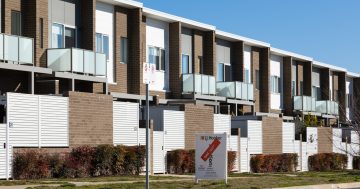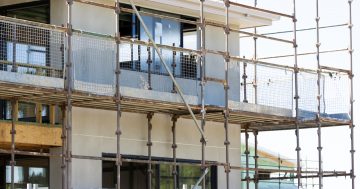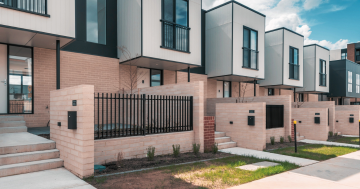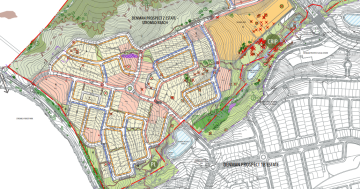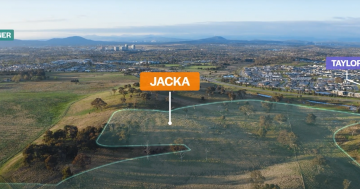
The ACT Government wants to see more townhouses, duplexes and row houses in Canberra’s residential areas. Photo: Michelle Kroll.
The ACT Government needed to stop issuing planning statements and let builders get on with delivering new housing types to Canberra’s established suburbs, according to Master Builders ACT.
Planning Minister Chris Steel’s flagging of more planning reforms to allow the building of more missing-middle homes – townhouses, duplexes and row houses – has been generally welcomed, but Master Builders ACT CEO Michael Hopkins said the time for action to boost housing supply was now.
Canberra Liberals planning spokesperson Peter Cain said Canberra needed more missing middle homes, but not at the expense of Canberra’s ‘bush capital’ and ‘garden city’ characteristics.
Mr Hopkins said the Minister’s Planning Statement repeated what was already recommended in last September’s Committee Inquiry into the Territory Plan, and what industry and housing stakeholders had been saying for years.
“While we welcome the Minister’s commitment to drafting a missing-middle design guide, much more action is needed to urgently address Canberra’s housing needs and remove current roadblocks,” he said.
“The new Territory Plan and Committee Inquiry gave the ACT Government the opportunity to change planning rules which would allow more appropriate housing to be delivered in Canberra.”
Mr Hopkins said all governments must urgently act on the planning blockages, workforce challenges, and over-regulation which was holding back development.
“Having to wait 18 months to two years for a new design guideline, and then longer again for zoning changes, means Canberrans will have to wait too long for appropriately designed middle housing,” Mr Hopkins said.
“Without immediate action, more Canberrans will be forced into inappropriate housing choices or be forced to look for housing across the NSW border.”

MBA ACT CEO Michael Hopkins: much more action is needed to remove current roadblocks. Photo: Region.
Mr Cain said Canberrans should be sceptical about any announcement on planning priorities given the government’s track record.
“Labor and the Greens have delivered an unclear and ineffectual new planning system, ignored the severe lack of integrity in planning governance, and consistently failed to provide genuine community and industry consultation,” he said.
Mr Cain agreed the ACT needed more residential housing, but blamed the problem on years of starved land release and obstructive development policies under Labor and the Greens.
He said medium-density homes can and should play a big part in achieving the ACT’s housing needs, but “we should be wary of this coming at the cost of Canberra’s ‘bush capital’ and ‘garden city’ characteristics, which are often present in our RZ1 areas”.
Mr Cain said the Liberals would release its policy package in the lead-up to the October election.
The Australian Institute of Architects ACT Chapter and the Planning Institute of Australia both welcomed Mr Steel’s commitment to prioritise missing-middle housing and develop a design guide.
Institute ACT Chapter president Shoba Cole said there needed to be more housing choice, dwelling typologies and density in the the RZ1 zone.
“We support Minister Steel’s ambition to connect housing density with transport infrastructure and key retail and commercial precincts,” she said.
“Increased housing density around our local shops will ensure the viability of tenancies and a more vibrant local community.”
The Institute’s ACT Chapter executive director, Rob Henry, said architects had long advocated more housing typologies for Canberra.
“We are delighted to now have the opportunity to assist the ACT Government with a design guide for the missing middle that will illustrate that our city is ready for alternative housing options,” he said.
Mr Henry said that innovative solutions could achieve housing density while maintaining the ACT’s garden-city principles.
“In the process of developing a design guide, we can ensure that a variety of housing typologies are tested on different block shapes and sizes and then set guidelines that produce the best outcome for the precinct,” he said.
“Many housing typologies, such as manor housing, actually have a smaller footprint and will offer more landscape for the residents.”
PIA ACT president Natalia Anderson backed Mr Steel’s plans, alongside a strategic planning approach to the location and scale of the proposed zoning changes.
Ms Anderson said there was a great opportunity to deliver more housing close to shopping centres and public transport to create a better-connected, accessible and sustainable city.
“PIA supports the proposed investigation to show how planning controls and the provision of housing in these locations may act as a catalyst for the revitalisation of centres, including those which are currently vacant, underutilised or ageing,” she said.












